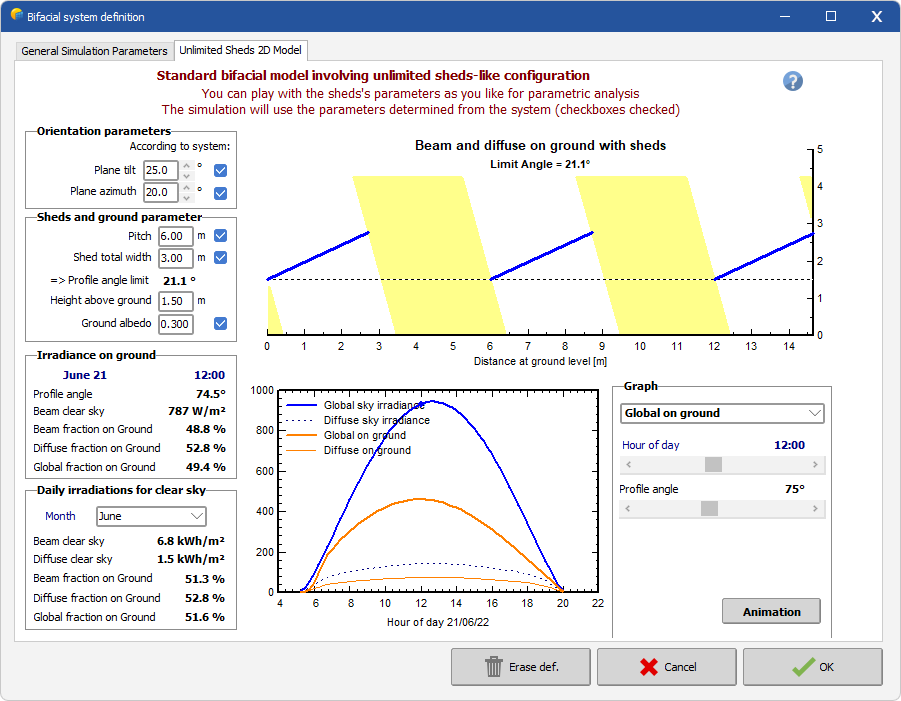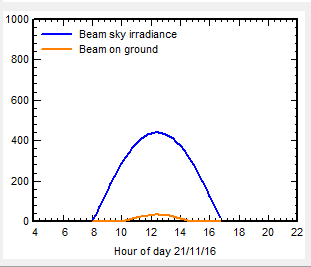Bifacial system: 2-dimensional unlimited sheds
For the basic principles of the bifacial simulation, please click here.
Important Hypothesis
This simplified 2D model is only applicable to large regular row-based systems (sheds). It neglects the edge effects at the extremities of the rows, and behind the last row.
Therefore, it is not well adapted to experimental systems with few modules.
This basic model treats - for the modeling of the backside irradiance - an orientation as a generic "Unlimited sheds" configuration, i.e., with identical pitch between rows, and without considering the row extremities. Note that it also does not differentiate between PV-sensitive areas and non-sensitive frames. Therefore you can use it:
- either directly with a simple system defined with the "Unlimited sheds" option in the orientation option,
- or with an orientation with a 3D representation, provided that the subsystem sufficiently large and regular for being approximated by the "Unlimited sheds" hypothesis.
The application of the model is as follows:
- PVsyst will create an approximate "Unlimited sheds" subsystem associated with your real PV system, just for the calculation of the bifacial features (i.e., the yield associated to the backside irradiance) during the simulation.
- This "added" subsystem should be similar to the 3D subsystem (the part corresponding to the same orientation) defined in the current variant.
- Prior to the simulation, except the height above the ground, all parameters of this "unlimited sheds" object will be adjusted according to your real 3D system. The parameters defined in the bifacial dialog are just here for a pedagogic analysis of the bifacial model in any conditions: they are not used in the simulation. Two optional checkboxes on the bifacial system window however allow to manually adjust the "pitch" and "number of rows" parameters. With this option, these parameters will override the ones from the 3D model, for the backside irradiance calculation.
2-dimensional calculation
The "unlimited sheds" hypothesis allows a simple analytic calculation of the shed's behavior, namely the mutual shading from row to row, considering one only direction.
This also simplifies the bifacial calculations: we can consider just the ground points distribution along the azimuth line, and we can analyze their behavior in terms of the row-to-row configuration.
Therefore, this dialog is also a powerful tool for the understanding of the bifacial systems issues, and its configuration optimization.
For this calculation, we have to specify the sheds parameters (Plane Tilt/Azimuth, Pitch, shed width, height above the ground), as well as the Ground albedo.
You can play with these values as you like, and get evaluations of many parameters in diverse conditions. However at simulation time, the parameters as close as possible from the basic systems will be used.
The dialog shows:
- The basic parameters of the sheds disposition,
- An evaluation of the ground irradiance for some specified dates (clear day),
- An evaluation of the daily irradiance values for each month (clear day conditions),
- A drawing - with animation - of the sheds and ground irradiance behaviors (beam, diffuse acceptance, ground re-emission, etc),
- Some distributions of parameters, see below.
Beam acceptance on ground: this highly varies according to the season. Here for November at latitude 43° North (instead of June just above):
Beam on Ground, and reflected : only a part of the illuminated ground re-emits to the collectors.
Diffuse acceptance: depends on the position of the ground point below the sheds.



